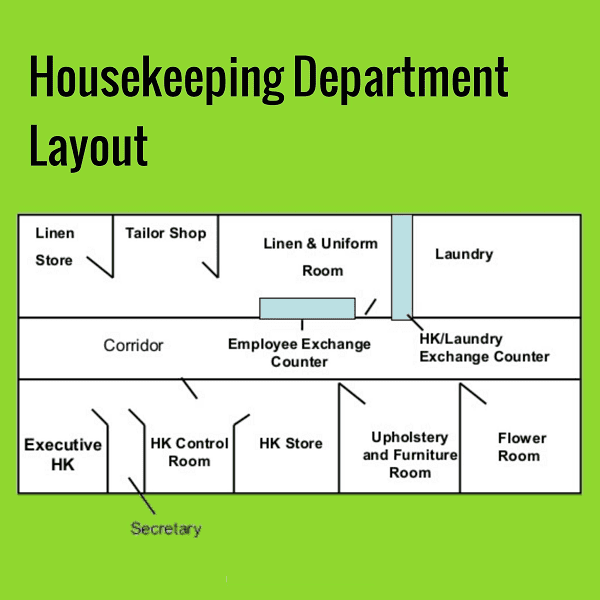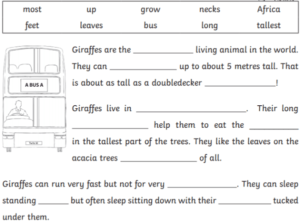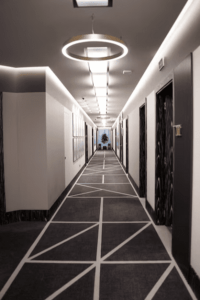Layout of Housekeeping Department- The layout of a housekeeping department in a hotel or any other facility may vary depending on the size and specific requirements of the establishment. However, there are some common areas and elements typically found in a housekeeping department layout:
- Housekeeping Office: This is the central administrative area where the housekeeping manager, supervisors, and administrative staff work. It is where scheduling, inventory management, and other administrative tasks are handled.
- Uniform Room: This is where housekeeping staff members store and collect their uniforms. It should also contain locker facilities for staff to change and store personal items.
- Linen and Laundry Room: This area is for storing clean linens, towels, and other supplies. It may also be connected to the laundry facilities where dirty linens are processed and cleaned.
- Housekeeping Storage: This is a storage area for cleaning supplies, equipment, and amenities such as extra toiletries and room supplies.
- Housekeeping Cart Storage: A dedicated space to store housekeeping carts and trolleys that are used to transport cleaning supplies and linens to guest rooms.
- Housekeeping Control Desk: Typically located near the main entrance to the housekeeping department, the control desk is where room assignments are made, and staff check in and out.
- Cleaning and Maintenance Area: This is where housekeeping staff can clean and maintain their equipment, such as vacuum cleaners and other tools.
- Guest Room Inspection Area: An area for inspectors to check the cleanliness and condition of guest rooms before they are made available for guests.
- Lost and Found: A designated area for storing items left behind by guests.
- Pantry or Housekeeping Supply Room: A storage area for frequently used supplies, such as cleaning chemicals, towels, and linens.
- Break Room: A space for housekeeping staff to take breaks and have meals.
- Restrooms and Changing Rooms: Restrooms and changing rooms for housekeeping staff to use during their shifts.
- Corridors: Wide corridors for ease of movement and to accommodate housekeeping carts and trolleys.
- Security Measures: Appropriate security measures like CCTV cameras, key card access, and locking systems to ensure the safety and security of staff and supplies.
- Loading Dock: For receiving deliveries of cleaning supplies, linens, and other materials.
- Trash Collection Area: A place to sort and store trash and recyclables before disposal.
It’s important to note that the layout and organization of a housekeeping department can be customized to suit the specific needs of the facility and its size. Effective organization and clear communication among housekeeping staff are crucial for maintaining cleanliness and efficiency in a hotel or similar establishment.
What is Layout of Housekeeping Department
The layout of a housekeeping department, which is typically found in a hotel or similar hospitality establishment, is designed to facilitate the efficient operation of cleaning and maintaining guest rooms and public areas. The layout may vary based on the size of the facility and specific needs, but here’s a general outline of the key areas and their arrangement:
- Housekeeping Office: This is the administrative hub of the housekeeping department. It’s where the housekeeping manager, supervisors, and administrative staff work. Tasks such as scheduling, inventory management, and communication with other departments are coordinated here.
- Uniform Room: A space where housekeeping staff can store their uniforms and personal belongings. It may include lockers and changing facilities.
- Linen and Laundry Room: This area is dedicated to the storage of clean linens, towels, and other supplies. It may also house the laundry facilities where soiled linens are processed and cleaned.
- Housekeeping Storage: A dedicated space for storing cleaning supplies, equipment, and additional amenities like toiletries and room supplies.
- Housekeeping Cart Storage: This area is used to store housekeeping carts and trolleys, which are essential for transporting cleaning supplies and linens to guest rooms.
- Housekeeping Control Desk: Located near the entrance of the department, this is where room assignments are made, and staff members check in and out at the beginning and end of their shifts.
- Cleaning and Maintenance Area: An area for housekeeping staff to clean and maintain their equipment, such as vacuum cleaners, mops, and other tools.
- Guest Room Inspection Area: A designated space where inspectors can thoroughly check the cleanliness and condition of guest rooms before they are made available for guests.
- Lost and Found: An area for storing items left behind by guests until they are claimed.
- Pantry or Housekeeping Supply Room: A storage space for frequently used supplies, including cleaning chemicals, towels, linens, and room amenities.
- Break Room: A designated space for housekeeping staff to take breaks, relax, and have meals during their shifts.
- Restrooms and Changing Rooms: Facilities where housekeeping staff can use the restroom and change clothes during their shifts.
- Corridors: Wide and easily navigable corridors to accommodate housekeeping carts and trolleys as they move throughout the department.
- Security Measures: Implement appropriate security measures, including CCTV cameras, key card access, and locking systems, to ensure the safety and security of staff and department resources.
- Loading Dock: A dedicated area for receiving deliveries of cleaning supplies, linens, and other materials.
- Trash Collection Area: A space to sort and temporarily store trash and recyclables before disposal.
The specific layout and organization of a housekeeping department can be customized to meet the unique needs of the facility, and it should promote efficiency and clear communication among staff members to ensure the cleanliness and maintenance of the establishment.
Who is Required Layout of Housekeeping Department
The layout of a housekeeping department is required for any establishment that provides accommodation services, such as hotels, motels, resorts, hostels, or similar hospitality businesses. A well-organized housekeeping department is essential to ensure the cleanliness, comfort, and overall satisfaction of guests. Here are the types of establishments that typically require a housekeeping department layout:
- Hotels: From small boutique hotels to large luxury chains, hotels of all sizes require an efficient housekeeping department to maintain guest rooms, public areas, and facilities.
- Resorts: Resorts with multiple accommodation options, such as hotel rooms, villas, or bungalows, need a comprehensive housekeeping department to manage a wide range of guest spaces.
- Motel Chains: Motels that are part of a chain or franchise often have standardized housekeeping department layouts to ensure consistent service quality.
- Hostels: Hostels, especially larger ones, benefit from an organized housekeeping department to manage dormitories, private rooms, and common areas.
- Bed and Breakfasts (B&Bs): Smaller B&Bs may have a simplified layout, but larger ones require efficient housekeeping operations to maintain guest rooms and common areas.
- Inns: Inns that offer accommodations typically have a housekeeping department responsible for maintaining guest rooms and common spaces.
- Extended Stay Accommodations: Properties that cater to guests on extended stays, such as corporate apartments or extended stay hotels, require organized housekeeping for long-term guest satisfaction.
- Vacation Rentals: Owners of vacation rental properties, including apartments and houses, often need to maintain their properties to a high standard and may benefit from housekeeping services.
- Cruise Ships: Cruise ships have elaborate housekeeping departments responsible for the cleanliness of cabins, public spaces, and more.
- Retirement Homes and Assisted Living Facilities: These facilities require housekeeping departments to maintain the living spaces and communal areas for residents.
The size and complexity of the housekeeping department will vary depending on the size of the establishment and the range of services provided. A well-designed layout and organization of the housekeeping department are essential to ensure that rooms are cleaned efficiently, linens are maintained, and guests’ needs are met promptly. Effective housekeeping is a critical aspect of guest satisfaction in the hospitality industry.
When is Required Layout of Housekeeping Department

The layout of a housekeeping department is required when an establishment provides accommodations or hospitality services and has dedicated personnel responsible for cleaning, maintaining, and servicing guest rooms and common areas. Here are some common scenarios and situations where a housekeeping department layout is required:
- Opening a New Hospitality Establishment: When a new hotel, motel, resort, hostel, bed and breakfast, inn, or any similar accommodation facility is being established, a housekeeping department layout is necessary to ensure efficient operations from the outset.
- Renovating or Expanding an Existing Establishment: If an existing hospitality establishment undergoes significant renovations or expansions that impact the housekeeping operations, a new layout may be required to accommodate these changes.
- Change in Ownership or Management: A change in ownership or management of a hospitality property may necessitate a review and update of the housekeeping department layout to align with new standards and expectations.
- Change in Brand or Franchise Affiliation: If a hotel or chain-affiliated property switches brands or franchises, the housekeeping department may need to adapt its layout to conform to the new brand’s standards and operational practices.
- Improving Efficiency and Guest Satisfaction: Establishments that want to enhance their housekeeping efficiency and guest satisfaction may choose to redesign or optimize their housekeeping department layout.
- Compliance with Regulations: Some regions and countries may have specific regulations or guidelines regarding the layout and operation of housekeeping departments in hospitality establishments. Compliance with these regulations is required.
- Upgrading Facilities: A property that upgrades its facilities or adds new services may need to revise the housekeeping layout to ensure that staff can effectively manage these new amenities.
- Operational Issues: If there are recurring operational issues or inefficiencies in the housekeeping department, a layout redesign may be necessary to address and resolve these problems.
The exact timing and necessity for a housekeeping department layout will depend on the specific circumstances and goals of the establishment. It is crucial for the layout to support the efficient and effective operation of the housekeeping department, as it plays a vital role in maintaining the cleanliness and quality of accommodations in the hospitality industry.
Where is Required Layout of Housekeeping Department
The required layout of a housekeeping department is typically located within the hospitality establishment itself, often in a designated area or floor of the building. The specific location may vary depending on the size and design of the facility, but it is typically situated in a centralized and easily accessible part of the building. Here are some common locations for the housekeeping department within various types of hospitality establishments:
- Hotels: In many hotels, the housekeeping department is situated on a dedicated floor or a specific area within the hotel. This area can be near the main entrance for easy access to guest rooms and public areas.
- Resorts: Resorts often have a centralized housekeeping department or housekeeping hubs located in various parts of the resort property, depending on the size and layout of the resort.
- Motel Chains: Motels that are part of a chain or franchise may have standardized layouts, and the housekeeping department is often located on the motel premises, either near the office or in a separate building.
- Hostels: Hostels may have a housekeeping area situated near the dormitories and private rooms, as well as in proximity to common areas.
- Bed and Breakfasts (B&Bs): Smaller B&Bs may have a simplified layout, with the housekeeping department located in a designated area within the property.
- Inns: Inns typically have a housekeeping area situated near the guest rooms, particularly if the inn offers dining or event facilities.
- Extended Stay Accommodations: Properties designed for extended stays, such as corporate apartments or extended stay hotels, often have a housekeeping area located near guest suites.
- Vacation Rentals: In the case of vacation rental properties, the housekeeping department may be off-site or managed by a separate cleaning service, but it must be well-organized and equipped for efficient operations.
- Cruise Ships: On cruise ships, the housekeeping department is typically spread across various decks, with specific areas designated for cleaning and maintaining cabins, public spaces, and laundry facilities.
- Retirement Homes and Assisted Living Facilities: In these facilities, the housekeeping department is located on-site, typically near living areas and communal spaces.
The specific location of the housekeeping department should be chosen to maximize operational efficiency, accessibility to guest areas, and staff convenience. It’s crucial for the layout to support the seamless management of cleaning, maintenance, and guest service functions within the establishment.
How is Required Layout of Housekeeping Department
The layout of a housekeeping department in a hospitality establishment is a critical component for ensuring efficient operations, guest satisfaction, and staff productivity. Here’s how to create a required layout for a housekeeping department:
- Assessment of Needs:
- Start by assessing the specific needs and requirements of your establishment. Consider the size of the property, the number of guest rooms, and the range of services offered. This assessment will help determine the necessary space and facilities.
- Consultation with Experts:
- Seek input from housekeeping managers, staff members, and interior designers or architects who have experience in designing housekeeping departments. They can provide valuable insights into the layout’s functionality.
- Define Zones:
- Identify different functional zones within the housekeeping department, such as storage areas, administrative spaces, laundry facilities, inspection areas, and staff facilities. Each zone should be designed to meet its specific purpose.
- Efficiency and Flow:
- Design the layout with an emphasis on workflow efficiency. Ensure that staff can easily move between areas and that supplies and equipment can be accessed conveniently.
- Accessibility:
- Ensure that the layout is accessible to all staff members, taking into consideration any mobility or accessibility issues. This includes the placement of ramps, elevators, and accessible restrooms.
- Safety and Security:
- Incorporate security measures, such as CCTV cameras and access control systems, to protect staff, resources, and sensitive areas like linen storage.
- Maximize Space:
- Make the most of the available space by utilizing vertical storage, compact equipment, and well-organized shelving and storage systems.
- Natural Lighting and Ventilation:
- If possible, design the layout to allow for natural light and ventilation, as it can create a more pleasant and productive work environment.
- Aesthetics and Comfort:
- Pay attention to aesthetics and comfort within the staff areas. Create a pleasant break room and restrooms to enhance the well-being of housekeeping staff.
- Signage and Labeling:
- Use clear signage and labeling for storage areas and key points of interest. This makes it easier for staff to find what they need quickly.
- Compliance with Regulations:
- Ensure that the layout complies with local building codes and regulations regarding space allocation, safety standards, and accessibility.
- Flexibility:
- Design the layout with flexibility in mind. This allows for adjustments as the needs of the establishment change over time.
- Regular Maintenance:
- Plan for regular maintenance of equipment and facilities to ensure that the housekeeping department remains in good working order.
- Testing and Evaluation:
- Once the layout is established, conduct testing and evaluation to ensure it meets the operational requirements. Make adjustments as necessary based on feedback from housekeeping staff.
- Documentation and Training:
- Create detailed documentation of the layout, including floor plans and labels for all key areas. Train housekeeping staff on the layout and operation procedures.
The layout of a housekeeping department should be customized to meet the specific needs of the establishment. It plays a crucial role in maintaining cleanliness, ensuring guest satisfaction, and supporting efficient housekeeping operations.
Case Study on Layout of Housekeeping Department
Background:
The Beachside Resort is a well-established beachfront hotel with 200 guest rooms, a restaurant, a spa, and conference facilities. While the hotel has been successful for many years, management identified the need to enhance efficiency and guest satisfaction by redesigning the layout of the housekeeping department. Several operational challenges had been identified, such as delays in room turnovers, difficulty in managing linen inventory, and inefficient use of staff resources.
Objectives:
- Improve the efficiency of cleaning and preparing guest rooms for check-in.
- Streamline the linen and laundry operations.
- Enhance staff convenience and well-being.
- Maintain compliance with all safety and accessibility regulations.
Process:
- Assessment and Needs Analysis:
- The project began with an in-depth analysis of the existing housekeeping department. This included interviews with housekeeping staff, observations of daily operations, and discussions with department managers to understand specific pain points.
- Consultation with Experts:
- An interior designer and architect were brought in to collaborate with the hotel’s management and housekeeping staff. They assessed the available space and provided recommendations for optimizing the layout.
- Layout Design:
- The new layout aimed to create functional zones within the housekeeping department:
- Administrative Area: A centralized control desk for room assignments and staff check-in/check-out.
- Linen and Laundry Zone: A dedicated space for linen storage and laundry facilities with direct access to guest room floors.
- Cleaning and Maintenance Area: A well-equipped area for cleaning equipment maintenance and storage.
- Staff Facilities: A spacious break room with natural lighting and comfortable seating, as well as clean and accessible restrooms.
- Secure Storage: Enhanced security measures, including key card access and CCTV cameras.
- The new layout aimed to create functional zones within the housekeeping department:
- Efficiency and Workflow:
- The layout was designed to facilitate a smooth flow of work. Cleaning carts and supplies were placed for easy access to guest rooms, and the linen and laundry zone was strategically located for quick replenishment of linens.
- Safety and Compliance:
- The layout included compliance with safety and accessibility regulations, including fire exits, proper ventilation, and appropriate storage of cleaning chemicals.
- Aesthetics and Comfort:
- Attention was paid to the aesthetics and comfort of staff areas to improve the well-being of housekeeping staff. Comfortable break room furnishings, soothing paint colors, and proper lighting were incorporated.
- Testing and Training:
- Before implementation, the new layout was tested with a group of housekeeping staff to receive feedback. Staff were trained on the new layout and operational procedures.
Results:
The redesigned housekeeping department layout yielded several positive outcomes:
- Improved Efficiency: Room turnovers were expedited, reducing wait times for guests. Staff could access supplies and equipment more efficiently, resulting in a significant increase in productivity.
- Streamlined Linen Management: The new linen and laundry zone allowed for better inventory control and faster replenishment of linens. This reduced delays in preparing rooms for guests.
- Enhanced Staff Satisfaction: The improved staff facilities and the comfortable break room created a more positive work environment and contributed to higher job satisfaction among housekeeping staff.
- Guest Satisfaction: Faster room turnovers and well-maintained guest rooms contributed to higher guest satisfaction scores.
- Compliance: The layout ensured full compliance with safety and accessibility regulations.
The optimization of the housekeeping department layout at the Beachside Resort not only improved operational efficiency but also elevated the guest experience and staff well-being, ultimately benefiting the hotel’s reputation and bottom line.
White paper on Layout of Housekeeping Department
Creating a white paper on the layout of a housekeeping department involves providing in-depth information and recommendations on how to design an efficient and effective layout for housekeeping operations in a hospitality establishment. Here’s a structure for a white paper on this topic:
Title: Optimizing the Layout of Housekeeping Departments in Hospitality Establishments
Abstract
- Briefly summarize the purpose, scope, and key findings of the white paper.
Table of Contents
- Introduction
- Provide an overview of the importance of housekeeping in the hospitality industry.
- Explain the purpose of the white paper.
- Challenges in Housekeeping Operations
- Discuss common challenges faced by housekeeping departments.
- Highlight the impact of inefficient layouts on guest satisfaction and staff productivity.
- Assessment and Needs Analysis
- Describe the initial steps in the layout optimization process, including assessing the specific needs of the establishment.
- Discuss the importance of involving key stakeholders, including housekeeping staff.
- Consultation with Experts
- Explain the role of interior designers, architects, and housekeeping managers in the layout design process.
- Discuss the benefits of seeking professional input.
- Layout Design Principles
- Outline the key principles of effective layout design:
- Functionality and Flow
- Accessibility and Mobility
- Safety and Security
- Space Utilization
- Aesthetics and Comfort
- Compliance with Regulations
- Outline the key principles of effective layout design:
- Functional Zones
- Describe the various functional zones within a housekeeping department:
- Administrative Area
- Linen and Laundry Zone
- Cleaning and Maintenance Area
- Staff Facilities
- Secure Storage
- Others, based on specific needs
- Describe the various functional zones within a housekeeping department:
- Efficiency and Workflow
- Discuss the importance of an efficient workflow in housekeeping operations.
- Explain how the layout should support a smooth flow of work.
- Safety and Compliance
- Emphasize the importance of safety measures and compliance with local regulations.
- Detail specific safety measures and features for an ideal layout.
- Aesthetics and Comfort
- Explain how aesthetics and staff comfort can impact morale and productivity.
- Provide examples of design elements that enhance the well-being of housekeeping staff.
- Testing and Training
- Highlight the importance of testing the layout before implementation.
- Discuss the training and documentation required to familiarize staff with the new layout and procedures.
- Results and Benefits
- Share the outcomes and benefits of optimizing the layout, such as improved efficiency, enhanced staff satisfaction, and higher guest satisfaction.
- Case Studies
- Include real-world case studies demonstrating successful layout optimization in hospitality establishments.
- Conclusion
- Summarize the key takeaways from the white paper.
- Reiterate the importance of a well-designed housekeeping department layout in the hospitality industry.
- Recommendations
- Provide recommendations for hospitality establishments looking to optimize their housekeeping department layouts.
- Appendices
- Include additional resources, such as checklists, sample layouts, and relevant regulations.
- References
- Cite sources and references used in the white paper.
Acknowledgments
- Acknowledge contributions from experts, staff, and consultants involved in the layout optimization project.
About the Author
- Briefly introduce the author or organization responsible for the white paper.
Contact Information
- Provide contact details for further inquiries or assistance.
A white paper on the layout of housekeeping departments in hospitality establishments can serve as a valuable resource for professionals in the industry looking to enhance their operations and guest satisfaction.





